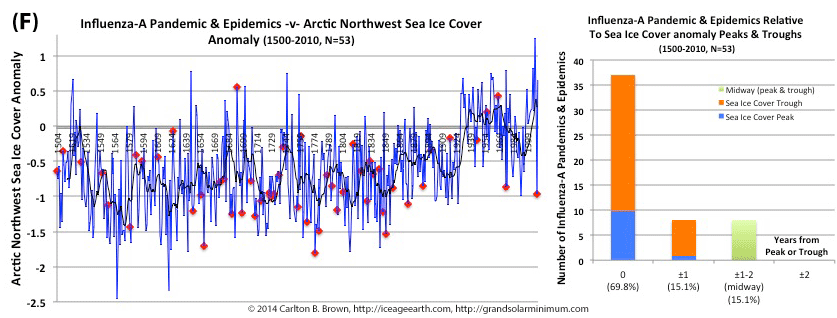The majority (94%) of all pandemics since 1500 CE occurred when the proxy used to determine the Arctic sea ice cover was lower the 1961-1990 average. Sea ice cover is derived from measuring the growth of underwater algae (proxy). Lower levels of algae growth happens when it is colder and there is more sea ice blocking the sun’s penetration below the surface. Likewise, half of all pandemics occurred at a trough in this algae growth.[i]
Click on this page and download a free copy of my book “Revolution: Ice Age Re-Entry,” and read more about this topic in Chapter 14—and find out why we should be very worried about a pandemic influenza outbreak this grand solar minimum.
[i] Data: (1) Jochen Halfar et al., 2013, Arctic sea-ice decline archived by multicentury annual-resolution record from crustose coralline algal proxy. Proceedings of the National Academy of Sciences. doi: 10.1073/pnas.1313775110. National Centers for Environmental Information, NESDIS, NOAA, U.S. Department of Commerce. Arctic Northwest Atlantic 646 Year Coralline Algae Sea Ice Record. https://www.ncdc.noaa.gov/paleo/study/15454. (2) Influenza pandemic and epidemic publications: (a) B. Lina, 2008, History of Influenza Pandemics. In: Raoult D., Drancourt M. (eds) Paleomicrobiology. Springer, Berlin, Heidelberg. https://doi.org/10.1007/978-3-540-75855-6_12. (b) E. Tognotti, 2009, Influenza pandemics: a historical retrospect. Journal of Infection in Developing Countries, 3:331-334. doi: https://doi.org/10.3855/jidc.239. (c) C. Potter, 2001, A history of influenza. Journal of Applied Microbiology, 91: 572-579. doi:10.1046/j.1365-2672.2001.01492.x. (d) J.K. Taubenberger and D.M. Morens, 1918 Influenza: the Mother of All Pandemics. Emerging Infectious Diseases. 2006;12(1):15-22. doi:10.3201/eid1201.050979. (e) Edwin D. Kilbourne, Influenza. Chapter 1; History of Influenza. Springer Science & Business Media, 6/12/2012 – Medical. ISBN 978-1-4684-5239-6. (f) Svenn-Erik Mamelund, Influenza, Historical. December 2008. International Encyclopedia of Public Health, First Edition (2008), vol. 3, pp. 597-609. DOI: 10.1016/B978-012373960-5.00372-5.


